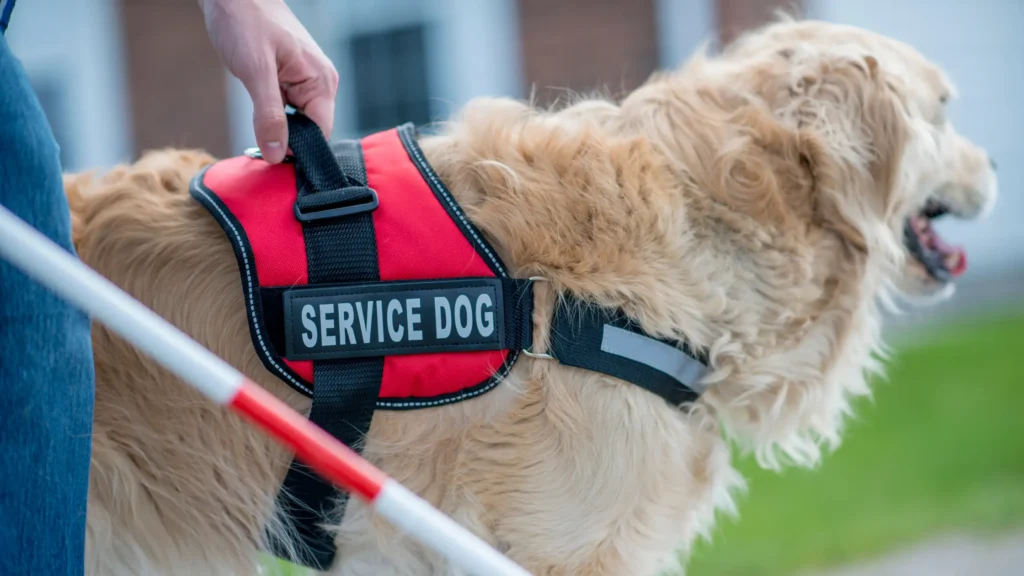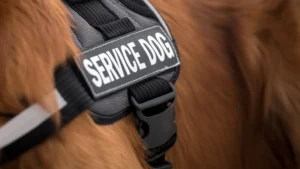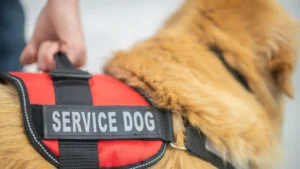Training a service dog is a labor of love and dedication. This amazing process creates life-changing partnerships between people and their canine companions. But it also requires significant time and commitment on an ongoing basis. In this comprehensive guide, we will walk through the various phases of selecting, socializing, and teaching these intelligent animals and understand about how long does it take to train a service dog. We’ll also discuss key factors that impact service dog training timelines. By understanding the full scope, you’ll appreciate why it takes approximately 1.5-2 years for a dog to complete this transformative journey into a working service animal.
Choosing Dogs with the Right Temperament – A Critical First Step
The very first step in embarking on this journey does not involve training at all. Rather, it focuses on carefully choosing candidate dogs well-suited for the job. A dog’s breed and their unique personality play a pivotal role in determining suitability for service work. So let’s explore what traits and characteristics trainers look for.
Seeking Out Specific Breeds Built for Service Roles
Certain breeds tend to excel in service capacities based on selective breeding to produce predictable traits. For example, the mild-mannered and highly trainable Labrador Retriever and Golden Retriever have proven well-adapted over decades of service guidance. More recently, some organizations also carefully bred their customized bloodlines to further specialize abilities. Additionally, a dog’s expected lifespan can influence breed selection, aiming to maximize their working years partnered with a human handler. Therefore, giant breeds face greater scrutiny compared to smaller or medium-sized counterparts when assessing suitability.
Assessing Individual Dog Temperaments
While breed certainly matters, each dog has unique personality aspects. Evaluating temperament provides pivotal insight into training potential. Calmness, attentiveness, responsibility, and people-focused bonding all indicate better prospects. Equally important is evidence of resilience when encountering novel or chaotic stimuli without overreacting. Early temperament screening allows trainers to match dogs appropriately to either active-duty or alternate roles more aligned with their natural capabilities.
Socializing Puppies – Building Confidence Through Exposure
You can’t fast-track experience. Therefore starting socialization early in a puppy’s life plays an integral role in setting the stage for excellence. Skill building depends first and foremost on relevant exposure under the right conditions to promote learning.
Desensitizing to Noises, Surfaces and Environments
Dogs reliant primarily on hearing and smell can feel initially overwhelmed by situations unfamiliar to them. But the systematic, positively-reinforced introduction to sights, sounds, and settings allows acclimation. This meaningful exposure teaches them slipper floors feel okay, loud trucks passing won’t harm them, and that new places hold adventure, not anxiety. Each realization bolsters confidence.
Interacting with Animals and People
Socialization also entails meeting both animals and humans to avoid overstimulation later during training or working. Puppies learn cats don’t need chasing, kids deserve gentle manners and strange adults may have treats. This breadth of applied experience pays dividends when expectation meets reality in maturity.
Mastering Foundation Obedience Commands
You must walk before you can run. The same applies to service puppies when establishing baseline competencies required for public access and working functions. Core obedience skills engrain structure, focus, and engagement.
Understanding Key Instructions
Simpler verbal or hand-signaled directions like “sit”, “stay” or “come” require human and canine collaborators to interpret mutually. Achieving consistent reliability indicates the partnership can handle more nuanced communication moving forward. Always reward progress to motivate more!
Applying Obedience in Public Settings
The controlled home environment differs drastically from the outside world. Evaluating obedience amid the unpredictability of parks or streets prepares for realistic distractions. Dogs resisting the temptation to sniff squirrels or greet strangers demonstrate exceptional impulse control for their age. This tempered independence permits handling more impactful tasks soon.
Advancing to Public Access Lessons
Once confident with obedience, dogs enter specialized public access training to simulate real-world expectations. Success confirms they can focus where needed most – their person.
Practicing Dog Manners Around Food and People
Many dogs instinctually react to scents wafting from grills or fresh picnics. Others may solicit affection from anyone they meet. Both behaviors detract from giving handlers full attention. So trainers reinforce polite indifference and close working proximity in these triggering situations until habit overrides impulse even when excited.
Getting Comfortable Around Traffic and Crowds
Similarly, tolerance for disruptive noises, vehicles, or bustling crowds must improve through exposure therapy. Stimulation once frightening becomes the status quo. This mental shift liberates service animals to concentrate on tasks not distractions. Confidence is liberating!
Learning Custom Tasks to Assist with Disabilities
Helping counter symptoms of a disability all comes down to this advanced training stage. Dogs build specialized skills catered to mitigate issues creating hardship and uncertainty for those they serve.
Mobility and medical service dogs
For people with mobility limitations, their assistance dog may retrieve dropped items, open doors or hit handicap door buttons. For those prone to seizures or diabetic comas, clever canines can activate alerts to danger through scents imperceptible to human handlers.
Psychiatric and Other Assistance
Psychiatric service animals offer relief as well. They can sense panic attacks fast approaching, eventually intervening to ease – grounding and comforting their person. Some even deliver medication or assist ambulation for those overwhelmed when symptoms flare. Each dog’s niche training targets building specific strengths.
Maintaining Skills Takes Ongoing Practice
Graduation signals the end of initial instruction, but serving by someone’s side demands constant training reinforcement. Dogs coming and going anywhere must generalize earlier expertise. Also, professional confirmation never stops, regularly reassessing public access quality.
Re-Training in Diverse New Settings
Unique locations meet unique needs. Fine-tuned training attunes support precise to evolving environments, enabling seamless service despite disruption. Traveling, storm chaos, or holiday havoc all transform settings. Adaptability is invaluable.
Confirming Reliability Through Testing
External evaluation by accreditation bodies ensures owner-led instruction achieves standards on par with expensive program dogs. These impartial milestones qualify skills transfer successfully from training to application. They also identify abilities possibly eroding.
Considering Retirement When Work Declines
Finally, watching for changes indicating decline – from slowing pace to sensing nearby seizures less quickly – helps determine transition time from active duty. This vigilance ensures peak support until the last working moment before a well-earned rest.
Key Factors Impacting Training Timelines
While the above overview outlines the comprehensive training process, predictably individual dog variation contributes to unique diversity. We’ll briefly highlight influences explaining divergent time investments. A dog’s specific breed and temperament set expectations from the start. Those predisposed towards focused working roles often pursue aptitude faster. Similarly, custom tailoring training to mitigate handler disabilities also speeds alignment. Professional trainers equipped with expertise streamline pathways owner-guided improvisation can rarely replicate in impact or time savings.
But above all, consistency and dedication synchronize team cohesion for both species daily so progress sticks for these beloved partners. In summary, although highly rewarding, training up a working service dog requires an extensive commitment over years by the dog and human alike. But unlocking independence and confidence for someone in need makes each rewarding moment they grow together along the journey. The fruits of this loving labor last a precious lifetime.
FAQ about How Long Does It Take to Train a Service Dog
How long does it take to train a service dog?
The duration of service dog training varies but typically ranges from several months to two years, depending on factors such as breed, temperament, and the complexity of tasks.
- Training duration varies based on breed and task complexity.
- It can range from several months to two years.
- Consistency and patience are key to successful training.
What tasks do service dogs learn?
Service dogs are trained to perform a variety of tasks tailored to their handler’s specific needs, including retrieving items, providing mobility assistance, alerting to medical conditions, and offering emotional support.
- Tasks vary based on handler requirements.
- Examples include retrieving items and providing mobility assistance.
- Training focuses on enhancing independence and safety.
Can any dog become a service dog?
While any dog has the potential to become a service dog, certain breeds are better suited to this role due to their temperament, trainability, and suitability for the tasks required.
- Breed selection is based on temperament and trainability.
- Some breeds are better suited for service work.
- Training focuses on individual dog capabilities.
What training methods are used for service dogs?
Service dog training relies on positive reinforcement techniques, clear communication, and consistency to teach desired behaviors and tasks. These methods emphasize rewards for correct responses and foster trust between the dog and its handler.
- Positive reinforcement techniques are employed.
- Clear communication and consistency are emphasized.
- Training fosters trust and cooperation.
Can I train my own service dog?
While some individuals choose to train their own service dogs, it’s essential to consider the extensive time, effort, and expertise required for successful training. Working with a reputable service dog organization or trainer can provide guidance and support throughout the training process.
- Owner training requires dedication and expertise.
- Working with professionals is recommended.
- Training organizations offer guidance and support.
How do I find a qualified service dog trainer?
Finding a qualified service dog trainer involves researching reputable organizations, evaluating trainer credentials and experience, and seeking recommendations from trusted sources. Look for trainers who specialize in service dog training and prioritize positive reinforcement methods.
- Research reputable training organizations.
- Evaluate trainer credentials and experience.
- Seek recommendations from trusted sources.
Useful Equipment
- Fresh Breathies to finally kiss bad doggie breath goodbye.
- Brush for dog hair.
- Dog Grooming Kit
- Pet Hair Lifter
- The Best High Quality Dog Food
- Pet Merchandise.
Useful Courses
- Brain Training for Dogs – the best & most effective dog training course in the market right now.
So, let us know did you find this article helpful? Are there any other questions you would like us to answer?
Let us know in the comment section down below.
If you are a dog or pet lover in general here are a few more articles you may find interesting:
- HOW TO GET YOUR DOG OR PUPPY TO STOP BARKING
- HOW TO TEACH YOUR DOG TO ROLL OVER
- WHY DO DOGS BREATHE FAST
- HOW TO LEASH TRAIN YOUR DOG
- HOW TO TEACH YOUR DOG TO SHAKE



